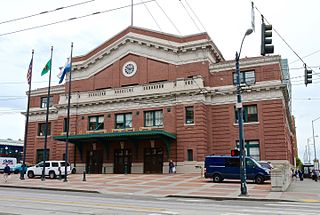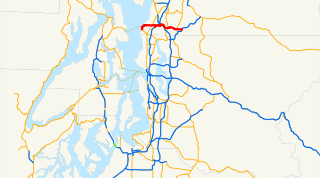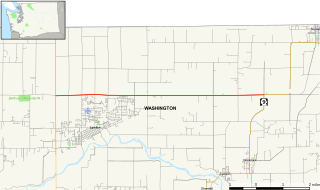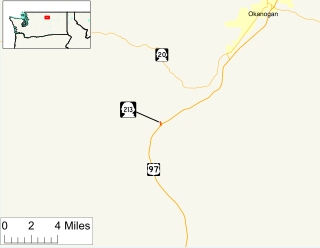Related Research Articles

Sound Transit (ST), officially the Central Puget Sound Regional Transit Authority, is a public transit agency serving the Seattle metropolitan area in the U.S. state of Washington. It operates the Link light rail system in Seattle and Tacoma, regional Sounder commuter rail, and Sound Transit Express bus service. The agency also coordinates the regional ORCA fare card system, which is also used by local transit operators. In 2017, Sound Transit services carried a total of 47 million passengers and averaged 157,000 riders on weekdays.

Community Transit (CT) is the public transit authority of Snohomish County, Washington, United States, excluding the city of Everett, in the Seattle metropolitan area. It operates local bus, paratransit and vanpool service within Snohomish County, as well as commuter buses to Downtown Seattle and the University of Washington campus. CT is publicly funded, financed through sales taxes, farebox revenue and subsidies, with an operating budget of $133.2 million. The entire agency carried more than 10 million passengers in 2015, placing it fourth among transit agencies in the Puget Sound region. The city of Everett, which serves as the county seat, is served by Everett Transit, a municipal transit system.
Spokane Transit Authority, more commonly Spokane Transit or STA, is the public transport authority of central Spokane County, Washington, United States, serving Spokane, Washington and its surrounding urban areas.
The Washington State Department of Transportation is a governmental agency that constructs, maintains, and regulates the use of transportation infrastructure in the U.S. state of Washington. Established in 1905, it is led by a Secretary and overseen by the Governor. WSDOT is responsible for more than 20,000 lane-miles of roadway, nearly 3,000 vehicular bridges and 524 other structures. This infrastructure includes rail lines, state highways, state ferries and state airports.

Kitsap Transit is a public transit agency serving Kitsap County, Washington, part of the Seattle metropolitan area. The system is based in Bremerton and operates bus service on 40 fixed routes, a foot ferry, a vanpool system, worker-driver services, and dial-a-ride services. The Kitsap Fast Ferries are also operated by Kitsap Transit.
State Route 9 (SR 9) is a 98.17-mile (157.99 km) long state highway traversing three counties, Snohomish, Skagit, and Whatcom, in the U.S. state of Washington. The highway extends north from an interchange with SR 522 in the vicinity of Woodinville north through Snohomish, Lake Stevens, Arlington, Sedro-Woolley, and Nooksack to become British Columbia Highway 11 (BC 11) at the Canada–US border in Sumas. Three other roadways are briefly concurrent with the route: SR 530 in Arlington, SR 20 in Sedro-Woolley, and SR 542 near Deming. A spur route in Sumas serves trucks traveling into British Columbia.

State Route 524 (SR 524) is a suburban state highway in the U.S. state of Washington, located entirely within Snohomish County. It begins at SR 104 in Edmonds and travels east past SR 99, Interstate 5 (I-5), under I-405, past SR 527 and SR 9 to end at SR 522 in Maltby. The road also has two spur routes, one connecting to SR 104 in Edmonds and another connecting to I-5 in Lynnwood.

Island Transit is a zero-fare transit system in Island County, Washington, serving Whidbey Island and Camano Island. The system consists of fixed-route bus service, paratransit, and vanpools, and carried a total of 974,899 passengers in 2015. There is no Sunday or holiday service on Island Transit routes.
State Route 527 is a state highway in Snohomish County, Washington. It travels 9 miles (14 km) from north to south, connecting the northern Seattle suburbs of Bothell, Mill Creek, and Everett. The highway intersects Interstate 405 (I-405) at its southern terminus, SR 96 in northern Mill Creek, and I-5 at an interchange with SR 99 and SR 526 in Everett.
Skagit Transit is a public transit system in Skagit County, Washington, US. It operates 18 bus routes, as well as dial-a-ride paratransit and vanpool services across the entire county. The agency was founded in 1993 and is funded by a 0.4 percent local sales tax.
The Whatcom Transportation Authority (WTA) is the public transit authority of Whatcom County in northwestern Washington, based in the city of Bellingham. It provides bus service on 31 fixed routes, including branded "GO Lines" with 15-minute frequencies on weekdays, to cities in its service area. In addition to bus service, the WTA offers paratransit service and a vanpool programs.
Clallam Transit is the public transportation provider for Clallam County, Washington. It provides 12 fixed-route buses, and coordinates with nearby transit organizations to provide 2 intercounty commuter bus lines. It also provides paratransit for disabled riders.

State Route 153 is a 30.78-mile (49.54 km) long state highway in the U.S. state of Washington, serving as part of the Cascade Loop in Okanogan County. The Methow Valley Highway begins at an intersection with U.S. Route 97 (US 97) in Pateros at the confluence of the Methow River and the Columbia River. SR 153 travels northwest, parallel to the Methow River, to end at SR 20 south of Twisp. The highway was first established in 1897 as the Methow-Barron Road and was designated as various highways, including State Road 12 from 1905 to 1919, the Roosevelt Highway from 1919 to 1923, and Primary State Highway 16 (PSH 16) until the 1964 highway renumbering, when it became SR 153.

State Route 546 (SR 546) is a state highway in Whatcom County, Washington, United States. It runs east–west for 8 miles (13 km) near the Canadian border, connecting SR 539 near Lynden to SR 9 near Nooksack and Sumas. The highway is a major freight corridor and serves as an alternate route between Bellingham and the Sumas border crossing.
U.S. Route 97 in the U.S. state of Washington is a 322-mile (518 km) route which traverses from the Oregon state line at the northern end of the Sam Hill Memorial Bridge in Maryhill, north to the Canada–US border in Okanogan County near Oroville. The highway serves major cities such as Goldendale, Yakima, Ellensburg and Wenatchee before continuing towards the Alaska Highway at the Yukon border as British Columbia Highway 97. Along the length of the roadway, US 97 is concurrent with State Route 14 in Maryhill, Interstate 82 (I-82) and US 12 between Union Gap and Ellensburg, I-90 briefly in Ellensburg, US 2 between Peshastin and rural Douglas County and SR 20 near Omak. An alternate route connects the highway with Chelan.

State Route 213 (SR 213) is the shortest state highway in the U.S. state of Washington. The 0.35-mile (0.56 km) long unsigned highway serves Malott, a community in Okanogan County. Extending from U.S. Route 97 (US 97) over the Okanogan River via a bridge to First Avenue in Malott, the roadway is semi-complete, as state law designates that the road should extend to SR 20 southwest of Okanogan. First appearing in a map in 1954, SR 213 originated as a branch of Primary State Highway 16 (PSH 16) in 1959 and later SR 20 Spur in 1964. SR 20 Spur became SR 213 in 1973 because another SR 20 Spur was recently established in Anacortes.

The Mason Transit Authority (MTA), formerly the Mason County Transportation Authority, is the public transit authority of Mason County, Washington, United States. It operates free bus service within the county, connecting the city of Shelton, Hoodsport, Grapeview, Allyn, Belfair, the native tribal reservations of the Skokomish and Squaxin people, and paid commuter service to Olympia in Thurston County, Brinnon in Jefferson County, and Bremerton in Kitsap County. The agency also provides general public dial-a-ride service, operates a vanpool fleet, a worker/driver program that provides commuter service to the Puget Sound Naval Shipyard and Intermediate Maintenance Facility, volunteer driver program for senior transportation, a supplemental service that is an after school activity bus and a community van program.
TranGO, also known as the Okanogan County Transit Authority (OCTA), is a public transit agency that provides bus service in Okanogan County, Washington.
The Grant Transit Authority is a public transit operator in Grant County, Washington. It operates 13 routes, including intercity services that converge in the city of Moses Lake.

The Swift Green Line is a bus rapid transit route in Snohomish County, Washington, United States, part of the Swift network operated by Community Transit. It was opened in 2019 and travels 12.5 miles (20.1 km) along Airport Way and State Route 527, connecting 32 stations in the cities of Everett, Mill Creek, and Bothell. Its termini are at Seaway Transit Center, adjacent to the Boeing factory, and Canyon Park Park and Ride on Interstate 405; the Green Line also intersects the Blue Line in Everett and also serves Paine Field.
References
- 1 2 3 4 Joint Transportation Committee (January 2015). "Local/Regional Jurisdictions" (PDF). Washington State Transportation Resource Manual (Report). Washington State Legislature. pp. 352–355. Retrieved July 14, 2016.
- 1 2 "Public Transportation Systems". Municipal Research and Services Center. October 2013. Retrieved July 12, 2016.
- 1 2 Passenger-Only Ferry Business Plan and Long Range Strategy: Summary Report (PDF) (Report). Kitsap Transit. December 2014. p. 4. Retrieved July 12, 2016.
- ↑ "Chapter 36.57A RCW: Public Transportation Benefit Areas". Revised Code of Washington . Washington State Legislature . Retrieved July 12, 2016.
- ↑ "RCW 82.14.045: Sales and use taxes for public transportation systems". Revised Code of Washington. Washington State Legislature. Retrieved July 12, 2016.
- ↑ Public Transportation Division (December 2014). 2013 Summary of Public Transportation (PDF) (Report). Washington State Department of Transportation . Retrieved July 12, 2016.
- ↑ "RCW 36.57.110: Boundaries of unincorporated transportation benefit areas". Revised Code of Washington. Washington State Legislature. Retrieved July 12, 2016.
- ↑ White, Richard O., ed. (July 1, 1975). "Chapter 270 (Engrossed Substitute Senate Bill No. 2280): Public Transportation" (PDF). 1975 Session Laws of the State of Washington - 1st Extraordinary Session, Forty-Fourth Legislature. Session Laws of the State of Washington (1975 ed.). Olympia, Washington: Washington State Legislature. pp. 979–993. OCLC 42336168.
- ↑ Brooks, Diane (December 30, 1994). "Sno-Tran Has Met Goals, Calling It A Day -- Tomorrow Ends Decade Of Success For Transit Agency". The Seattle Times. Retrieved July 12, 2016.
- ↑ Public Transportation and Rail Division (September 1997). "Community Transit". Public Transportation Systems in Washington State, 1996 Summary (PDF) (Report). Washington State Department of Transportation. p. 27. Retrieved July 12, 2016– via National Transportation Library.
- ↑ Planning, Research and Public Transportation Division (October 1984). "Local Transit". Public Transportation in Washington State, 1984 (PDF) (Report). Washington State Department of Transportation. pp. 19–20. OCLC 13007541 . Retrieved July 12, 2016– via National Transportation Library.
- ↑ Kimpel, Thomas (September 27, 2013). "2013 Public Transportation Benefit Area Population Estimates" (PDF). Washington State Office of Financial Management. Archived from the original (PDF) on February 3, 2014. Retrieved July 12, 2016.
- ↑ "Accountability Audit Report: Asotin County Public Transportation Benefit Area". Washington State Auditor's Office. November 30, 2015. p. 5. Retrieved January 26, 2017.
- ↑ Woebler, Bob (May 20, 1980). "Tri-City voters approve mass transit system 2-1". Tri-City Herald . Kennewick, Washington: The McClatchy Company.
- ↑ "BFT History". Ben Franklin Transit . Retrieved July 12, 2016.
- ↑ "History". Clallam Transit. Archived from the original on September 29, 2015. Retrieved July 12, 2016.
- ↑ "Facts/Ridership & Budget". Clallam Transit. Archived from the original on September 29, 2015. Retrieved July 12, 2016.
- ↑ Lane, Bob (June 2, 1976). "Snohomish County bus system OK'd". The Seattle Times . p. A10.
- ↑ "Community Transit Marks 35th Anniversary" (Press release). Everett, Washington: Community Transit. October 3, 2011. Retrieved July 12, 2016.
- ↑ Heath, Emmett (May 27, 2014). 2013 Comprehensive Annual Financial Report, Years Ending December 31, 2013 and December 31, 2012 (PDF) (Report). Community Transit. p. 109. Archived from the original (PDF) on September 5, 2014. Retrieved July 12, 2016.
- ↑ "History". Grant Transit Authority . Retrieved July 12, 2016.
- ↑ "30th Anniversary Survey Feedback Positive". Intercity Transit. 2011. Archived from the original on August 7, 2016. Retrieved July 12, 2016.
- ↑ "Statistical Information". Jefferson Transit. February 2011. Retrieved July 12, 2016.
- 1 2 "About Link Transit". Link Transit. Archived from the original on April 20, 2016. Retrieved July 12, 2016.
- ↑ "History of MTA". Mason Transit Authority. Archived from the original on March 6, 2015. Retrieved July 12, 2016.
- ↑ LePage, Caroyln (December 31, 2008). Annual Report: Mason County Public Transportation Benefit Area Authority (MTA) (PDF) (Report). Mason County Transportation Authority. p. 3. Retrieved July 12, 2016.[ permanent dead link ]
- ↑ "About Us". Pierce Transit . Retrieved July 12, 2016.
- ↑ "Section 3: Service Characteristics". 2013 Annual Report and 2014-2019 Transit Development Plan (PDF) (Report). RiverCities Transit. August 13, 2014. p. 5. Retrieved July 12, 2016.
- 1 2 "Fact Sheet: Skagit Transit History and Demographics". Skagit Transit. 2011. Retrieved July 12, 2016.
- 1 2 "Spokane Transit Celebrates 35th Anniversary". Spokane Transit Authority . Retrieved May 9, 2021.
- ↑ "Okanogan County — Election results 2013". The Wenatchee World . November 5, 2013. Archived from the original on November 26, 2013. Retrieved July 12, 2016.
- 1 2 "Chapter 1: Introduction" (PDF). Okanogan County Transit Authority 2013 Transit Service Plan (Report). Okanogan County Transit Authority. March 11, 2013. p. 1. Retrieved July 12, 2016.
- ↑ Taxpayer Account Administration (January 29, 2014). "Okanogan County Transportation Tax, Effective April 1, 2014" (PDF). Washington State Department of Revenue. Retrieved July 12, 2016.
- ↑ "Section 3: Service Characteristics" (PDF). 2013 Annual Report & Transit Development Plan 2014–2019 (Report). Twin Transit. August 15, 2014. p. 6. Retrieved July 12, 2016.
- ↑ "History of Valley Transit". Valley Transit . Retrieved July 12, 2016.
- ↑ Whatcom County Council (March 10, 1983). "Whatcom County Council Minutes: Public Transportation Benefit Area (PTBA)" (PDF). Whatcom County. p. 2. Retrieved July 12, 2016.
- ↑ Whatcom Transportation Authority (April 12, 2007). "Request for Proposal for Insurance Broker/Consultant Services #2007-500" (PDF). Municipal Research and Services Center. p. 3. Retrieved July 12, 2016.[ permanent dead link ]